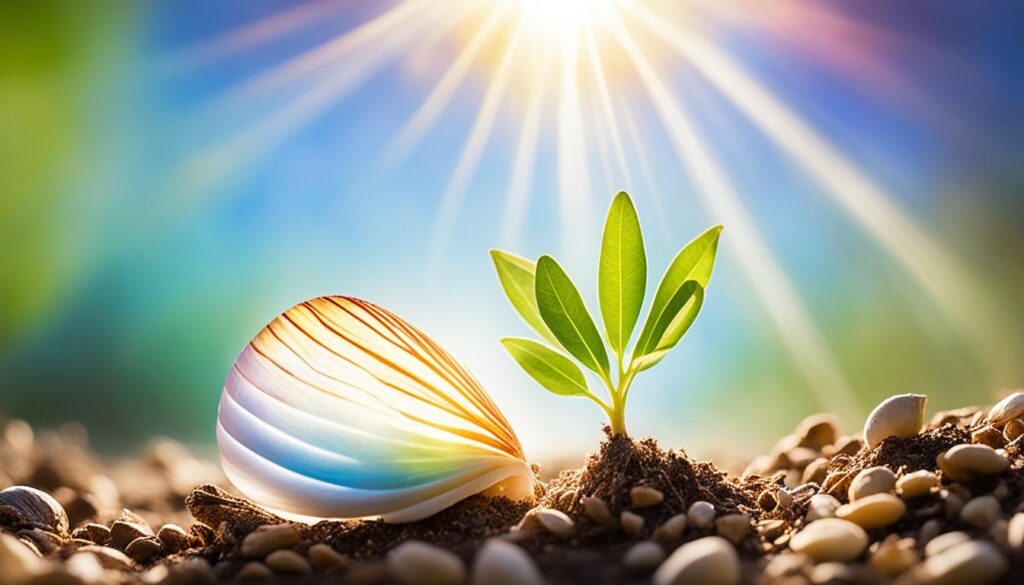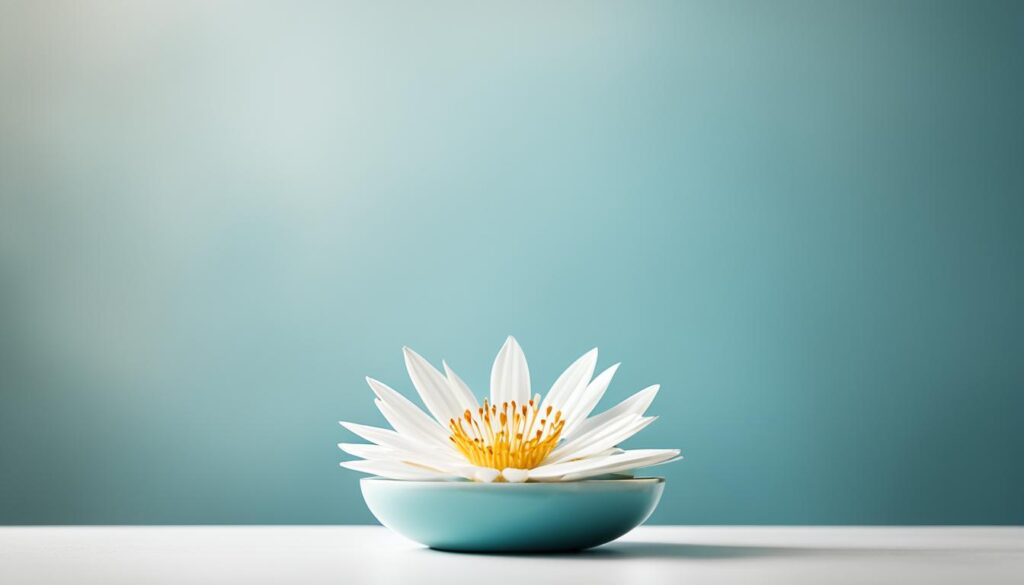Coping Strategies
Be In Stillness – Find Clarity for Mindful Living

Were you aware that the typical individual experiences more than 6,000 thoughts daily? This immense count of contemplations, concerns, and diversions are perpetually whirring within our heads. Given this incessant mental clamor, it’s hardly surprising that achieving clarity in life often seems like a Herculean endeavor. However, imagine there existed a method to mute the turmoil and nurture a peaceful mind?
Introducing stillness – the practice of embracing mindful living to achieve mental clarity and peace. By intentionally creating moments of quiet and disconnecting from external distractions, we can tap into our inner wisdom and find clarity in life. Stillness is not just about escaping the noise; it’s about fully embracing the present moment and experiencing life with greater awareness.
In this article, we will explore the power of stillness and how it can help overcome overthinking, curb mental restlessness, and unlock our true potential. We’ll delve into the importance of cultivating awareness, practicing self-reflection, and cultivating qualities like gratitude and compassion. We’ll also learn practical tips for incorporating stillness into our daily lives, overcoming distractions, and developing focus.
Key Takeaways:
- Stillness is the practice of embracing mindful living to find clarity in life.
- By disconnecting from external distractions, we can tap into our inner wisdom and experience mental peace.
- Practicing stillness involves cultivating awareness, practicing self-reflection, and embracing qualities like gratitude and compassion.
- Stillness can be incorporated into our daily lives through activities like meditation, journaling, and exercise.
- Overcoming distractions and developing focus are essential in maintaining a stillness practice.
The Power of Stillness in Overcoming Overthinking
Overthinking can trap us in a cycle of mental noise and restlessness. The constant chatter in our minds can make it difficult to find peace and clarity. However, there is a powerful tool that can help us overcome overthinking and find a peaceful mind – stillness.
Stillness is more than just the absence of activity; it is a state of being fully present in the moment. By practicing mindfulness and being aware of our thoughts and emotions without judgment, we can create a space of stillness within ourselves. In this space, we can observe our thoughts without getting entangled in them, allowing them to pass by like clouds in the sky.
When we practice stillness, we give ourselves the opportunity to quiet the noise in our minds and find mental freedom. The distractions and worries that often consume our thoughts begin to lose their power as we focus on the present moment. We become more attuned to our inner selves and develop a deeper understanding of our thoughts and emotions.
Through stillness, we can cultivate a peaceful mind that is less prone to overthinking. We learn to let go of the need to control every thought and outcome, and instead, embrace the beauty of simply being. In this state of stillness, we find clarity and a sense of calm that allows us to navigate life with greater ease and joy.
“Stillness is not the absence or negation of energy, life, or movement. It is the nourishing ground for the realization of peace, clarity, and wisdom.” – Eckhart Tolle
The Benefits of Stillness in Overcoming Overthinking
The practice of stillness offers a range of benefits that can help us overcome overthinking and cultivate a peaceful mind:
- Clarity of thought: Stillness helps us clear the mental clutter and gain a clearer perspective on our thoughts and emotions.
- Reduced stress and anxiety: By finding stillness, we can reduce stress and anxiety levels, allowing for a greater sense of peace and well-being.
- Improved focus and concentration: Through stillness, we can train our minds to stay focused on the present moment, improving our ability to concentrate on tasks.
- Enhanced creativity: Stillness provides space for our creative ideas to flow and flourish, allowing us to tap into our creative potential.
- Increased self-awareness: By practicing stillness, we become more aware of our thoughts, emotions, and patterns of behavior, leading to greater self-understanding and self-compassion.
Incorporating stillness into our daily lives can have a profound impact on our overall well-being. It helps us overcome overthinking and fosters a sense of inner peace and clarity. By embracing the power of stillness, we can create space for growth, self-discovery, and a more peaceful mind.
Cultivating Awareness to Overcome Mental Restlessness
When it comes to finding clarity and peace of mind, awareness is a vital element in our journey. However, it goes beyond simply noticing our thoughts. It involves delving deeper and understanding the patterns of our mind. By cultivating awareness, we can start to unravel the complexities of our overactive thoughts and overcome mental restlessness.
Being aware of our habitual thought processes allows us to see the futility of overthinking. We begin to realize that continuously pondering over the same thoughts only burdens our mind further. Cultivating awareness enables us to let go of unnecessary mental burdens and embrace a more tranquil state of being.
“Awareness is like a gentle breeze that clears the fog of confusion, revealing the path towards clarity and peace of mind.”
Through the practice of awareness, we become observers of our thoughts. We develop the ability to detach ourselves from our swirling mental chatter and adopt a more impartial stance. This non-judgmental perspective allows us to release the hold that overthinking has on our thoughts and emotions.
Cultivating awareness is a gradual process that requires patience and practice. It calls for active engagement with our thoughts, emotions, and the present moment. As we deepen our understanding of our mental patterns, we gain the freedom to choose how we respond to our thoughts, rather than being controlled by them.
Benefits of Cultivating Awareness:
- Reduced mental restlessness
- Increase in clarity of thought
- Enhanced emotional well-being
- Improved decision-making abilities
- Greater self-awareness
By taking the time to cultivate awareness, we open the door to clarity and peace within ourselves. It is a transformative practice that empowers us to break free from the chains of mental restlessness and embrace a more serene state of being.
| Steps to Cultivate Awareness | Benefits |
|---|---|
| 1. Mindfulness meditation | Fosters present-moment awareness and reduces overthinking |
| 2. Journaling | Enhances self-reflection and understanding of thought patterns |
| 3. Breathwork exercises | Brings focus to the present moment and calms the mind |
| 4. Body scan meditation | Develops a deeper connection between the mind and body |
| 5. Engaging in mindful activities | Promotes a state of flow and heightened awareness |

By cultivating awareness, we can transcend the constant flurry of thoughts and find solace in the serenity of the present moment. It is through this practice that we can overcome mental restlessness and discover a profound sense of clarity and peace within ourselves.
The Importance of Stillness for Mental Clarity and Peace
In today’s fast-paced world, finding moments of stillness is essential for our mental well-being. It is during these serene pauses that we can disconnect from the external chaos and connect with our inner selves. By intentionally practicing stillness, whether through meditation, quiet walks, or moments of silence, we can achieve mental clarity and peace of mind.
Stillness allows us to quiet the constant chatter of our minds and center our thoughts. It provides us with the space to observe our thoughts without judgment, gaining a deeper understanding of ourselves and our experiences. This self-awareness leads to mental clarity, enabling us to make more conscious decisions and navigate life with greater ease.
When we embrace stillness, we create a sanctuary within ourselves, where our thoughts can settle, and our minds can rest. This state of calmness promotes a sense of tranquility and peace, allowing us to release stress and find solace in the present moment.
“In stillness, we find our true selves. It is within the silence that we hear the whispers of our soul, guiding us towards our most authentic path.”
The Benefits of Stillness
By prioritizing stillness in our daily lives, we can reap numerous benefits that enhance our overall well-being:
- Mental Clarity: Stillness helps clear the mental fog, allowing us to think more clearly, make better decisions, and solve problems efficiently.
- Reduced Stress: Taking moments of stillness helps reduce stress levels, promoting a sense of calm and improving our ability to manage everyday challenges.
- Enhanced Focus: By quieting the mind, stillness enhances our ability to concentrate, improving our productivity and performance in various tasks.
- Improved Emotional Balance: Stillness provides us with the space to connect with our emotions, fostering self-awareness and promoting emotional stability.
- Increased Resilience: Regular practice of stillness cultivates resilience, empowering us to face life’s uncertainties with a calm and composed mindset.

Comparing Different Stillness Practices
| Practice | Focus | Benefits |
|---|---|---|
| Meditation | Internal awareness | Improved focus, stress reduction, emotional balance |
| Quiet walks in nature | Connection with the environment | Enhanced mindfulness, reduced anxiety, increased creativity |
| Moments of silence | Internal reflection | Clarity of thought, emotional rejuvenation, improved decision-making |
By incorporating stillness into our daily routines, we create a foundation of peace and mental clarity that supports us in all aspects of life. It is through these moments of stillness that we find refuge and nourish our souls, allowing us to navigate the world with a renewed sense of purpose and tranquility.
Self-Reflection as a Key Aspect of Stillness
When we think of stillness, our initial focus may be on disconnecting from the external world. However, stillness goes beyond finding physical tranquility; it also involves a deep sense of self-awareness and reflection. Self-reflection plays a crucial role in our journey towards clarity and peace.
We must be willing to see ourselves as we truly are, without judgment or criticism.
Self-reflection is the practice of consciously exploring our thoughts, emotions, and actions without attaching labels or evaluating them. It allows us to observe our inner experiences with a compassionate attitude, embracing them as a part of our human nature.
By engaging in self-reflection, we develop a greater understanding of our emotional states and patterns. We gain insights into the root causes of our anxieties, fears, and worries. This process enables us to cultivate a compassionate attitude towards ourselves, recognizing that we are deserving of understanding, forgiveness, and self-acceptance.
Self-reflection brings light to the shadows within us and illuminates our path towards inner peace and growth.
Through stillness and self-reflection, we create a safe space where we can confront the inner turmoil and dissonance that may hinder our clarity. We learn to listen to our inner voice with kindness and curiosity, allowing valuable insights to emerge.
This practice of self-reflection also deepens our connection with others. As we develop compassion for ourselves, we naturally extend that same compassion towards others. We start to see the shared humanity beneath our surface differences, fostering empathy and understanding in our relationships.
Self-reflection offers us the opportunity to pause, reassess, and make conscious choices aligned with our values and aspirations. It allows us to align our actions with our authentic selves and create a life that is true to who we are.
| Benefits of Self-Reflection | How to Practice Self-Reflection |
|---|---|
|
|
Self-reflection is an ongoing practice that requires patience, openness, and a genuine desire to understand ourselves. As we continue to cultivate this skill, we unlock the power of stillness and embark on a transformative journey towards clarity, peace, and self-discovery.
The Power of Gratitude and Compassion in Stillness
In stillness, we have the opportunity to cultivate two powerful qualities that not only bring us peace of mind but also have the potential to transform the world around us. Gratitude and compassion, when practiced in stillness, enhance our well-being and create a ripple effect of positivity and kindness.
Gratitude is a shift in perspective, a conscious choice to focus on the blessings in our lives rather than dwelling on what is lacking. It allows us to appreciate the present moment and find joy in the simple things. When we practice gratitude in stillness, we train our minds to notice the small miracles and find contentment in the present.
“Gratitude turns what we have into enough.”
On the other hand, compassion is the heart’s response to the suffering and struggles of others. It is a deep empathy that moves us towards acts of kindness and understanding. When we practice compassion in stillness, we cultivate a sense of connection with all beings and foster a world infused with love and acceptance.
“Compassion is not a relationship between the healer and the wounded. It’s a relationship between equals. Only when we know our own darkness well can we be present with the darkness of others.” – Pema Chödrön
Together, gratitude and compassion create a harmonious synergy in our stillness practice. Gratitude brings us into alignment with the abundance of the present moment, while compassion expands our hearts and deepens our connection to the world. These qualities enrich our experience of stillness and open us up to a greater understanding of ourselves and others.
By nurturing a practice of gratitude and compassion in stillness, we become vessels of love and kindness. We bring these qualities into our interactions with others, infusing our relationships with empathy and understanding. Through stillness, we can create a ripple effect of gratitude and compassion that has the power to transform not only our own lives but the lives of those around us.
Embracing the Present Moment and Awakening to Potential
Embracing the present moment is a transformative practice that allows us to tap into the extraordinary potential that exists within our awareness. It goes beyond simply quieting the mind; it is about fully immersing ourselves in the richness of the ‘now’. By anchoring ourselves in the present, we can awaken to the depths of our inner clarity, making more conscious decisions and living a more intentional life.
The practice of stillness is a powerful tool on this journey of self-discovery. It provides us with a sanctuary of calm amidst the chaos of everyday life. Through stillness, we create a sacred space where we can connect with our deepest selves and access the wisdom that resides within us.
“In today’s fast-paced world, it’s easy to get caught up in the flurry of distractions and commitments. The practice of stillness helps us ground ourselves, allowing us to fully embrace the present moment and unlock our true potential.”
When we embrace the present moment, we become more attuned to our surroundings and the experiences that unfold before us. We start to notice the subtleties of life that often go unnoticed—the gentle sway of trees, the warmth of the sun on our skin, or the laughter of loved ones. By fully immersing ourselves in the present, we deepen our connection to the world around us and find profound joy in even the simplest of moments.
Awakening to our potential requires us to let go of past regrets and future anxieties, and instead focus on what is within our control—the present. It is in this moment that we have the power to shape our lives and make choices that align with our true values and aspirations.
Stillness practice guides us on this path of self-discovery by helping us cultivate a sense of inner spaciousness. It teaches us to observe our thoughts and emotions without judgment, allowing us to gain clarity and insight into our inner landscape.

The image above perfectly captures the essence of embracing the present moment and awakening to our potential. The serene lake reflects the calmness and clarity we can experience when we immerse ourselves fully in the present. It serves as a visual reminder of the transformative power that lies within stillness practice.
Through the practice of stillness, we open ourselves up to new possibilities and perspectives. We become more attuned to our intuition and inner guidance, allowing us to make decisions that align with our authentic selves. With each moment of stillness, we awaken to our true potential and step into a life filled with purpose and meaning.
Let us embrace the present moment, awaken our potential, and embark on a journey of self-discovery through the transformative practice of stillness.
The Power of Embracing the Present Moment:
- Experience a deeper connection to the world around us
- Find joy and beauty in even the simplest of moments
- Let go of past regrets and future anxieties
- Shape our lives through conscious choices
Awakening to Potential Through Stillness:
- Cultivate a sense of inner spaciousness
- Observe thoughts and emotions without judgment
- Gain clarity and insight into our inner landscape
- Open ourselves up to new possibilities and perspectives
The journey of embracing the present moment and awakening to our potential begins with stillness practice. It is through the intentional cultivation of present-moment awareness that we unlock the extraordinary potential that lies within each of us.
Small Steps Towards Stillness and Inner Voice Tuning
Reaching a state of stillness may seem overwhelming, but it starts with taking small steps and intentionally disconnecting from the noise and distractions around us. By incorporating simple practices into our daily routine, we can gradually cultivate a sense of tranquility and inner peace.
One powerful way to begin the journey towards stillness is through mindfulness. Mindfulness involves being fully present in the moment and observing our thoughts and emotions without judgment. It allows us to tune into our inner experiences and develop a greater awareness of our thoughts, feelings, and bodily sensations.
“Mindfulness is the key to unlock the door to stillness within.”
Another effective practice is meditation. Taking just a few minutes each day to sit in silence and focus on our breath can have profound effects on our mental well-being. It helps calm the mind, reduce stress, and cultivate a sense of inner clarity. With consistent practice, we can strengthen our ability to enter a state of stillness and tap into our inner wisdom.
Connecting with nature is another valuable pathway to stillness. Taking a peaceful walk in the woods, feeling the warmth of the sun on our skin, or listening to the sound of waves crashing on the shore can all bring us closer to a state of tranquility. Nature has a unique way of grounding us in the present moment and helping us find peace within.
As we journey towards stillness, it is important to tune into our inner voice and embrace self-reflection. Our inner voice is our intuition, guiding us towards what feels right and true for us. By taking moments throughout the day to listen to our inner voice, we can gain insights, make wiser decisions, and align with our authentic selves.
In the words of Rumi:
“Listen to silence. It has so much to say.”
By engaging in regular self-reflection, journaling, or contemplative practices, we can deepen our connection with our inner voice and tap into the profound wisdom that resides within us.
Remember, stillness is not achieved overnight. It is a lifelong practice that requires patience, dedication, and a compassionate attitude towards ourselves. But every small step we take towards stillness brings us closer to a more peaceful and fulfilling life.
The Benefits of Stillness in Mental Clarity and Focus
Stillness is a powerful tool for developing mental clarity and focus. By creating moments of stillness and disconnecting from distractions, we can train our minds to stay calm and focused. Activities like meditation, yoga, or walking help ground our thoughts and enhance our ability to be present. Ultimately, stillness strengthens our mental clarity and focus.
The Power of Stillness
In our fast-paced world, finding moments of stillness can be challenging. However, incorporating stillness practices into our daily lives can have numerous benefits for our overall well-being. When we allow ourselves to be still, we create space for our minds to quiet down and for mental clarity to emerge.
“In the midst of movement and chaos, keep stillness inside of you.” – Deepak Chopra
Training the Mind to Stay Calm
Practicing stillness allows us to cultivate an inner calmness that extends beyond moments of stillness. As we train our minds to stay calm in stillness, we develop the ability to remain focused even in challenging and chaotic situations. This mental resilience enables us to approach tasks with clarity and make more deliberate decisions.
Enhancing Mental Clarity and Focus
By disconnecting from external distractions and turning inward, stillness helps us sharpen our mental focus. When we are still, we can direct our attention to a specific task or thought, reducing mental clutter and increasing our ability to concentrate. This enhanced mental clarity allows us to prioritize effectively and accomplish tasks with greater efficiency.
Strengthening Mind-Body Connection
Stillness practices, such as yoga and meditation, promote a stronger mind-body connection. By slowing down and being present in our bodies, we become more attuned to our physical sensations, emotions, and thoughts. This heightened awareness enhances our ability to focus on the present moment and respond to our surroundings with clarity and intention.
Creating Space for Creative Thinking
When our minds are cluttered with distractions, it can be challenging to tap into our creativity. Stillness provides a space for our minds to settle, giving way to innovative and imaginative thinking. By allowing ourselves moments of stillness, we open ourselves up to new ideas, possibilities, and solutions to challenges we may face.
| Benefits of Stillness | Mental Clarity | Focus |
|---|---|---|
| Enhances concentration |  |
 |
| Elevates problem-solving skills |  |
 |
| Reduces stress and anxiety |  |
 |
| Enhances decision-making abilities |  |
 |
Spending intentional time in stillness allows us to tap into the benefits of mental clarity and focus. By making stillness a regular practice, we can enhance our ability to concentrate, think creatively, and make decisions with clarity. Whether through meditation, yoga, or other forms of quiet reflection, embracing stillness can have transformative effects on our mental well-being.
Building Confidence Through Stillness
Stillness practice has the power to build our self-confidence and empower us in various aspects of life. By creating moments of stillness, we tap into a state where nothing else matters, allowing us to become more confident and assertive. In this state of stillness, our posture, voice tone, and body language naturally shift, reflecting our newfound confidence and inner strength.
When we practice stillness, we cultivate a sense of inner calm, which directly impacts our external presence. Our stillness radiates poise and composure, making us appear more self-assured and approachable in our interactions. Others pick up on this energy and perceive us as confident individuals.
Embracing stillness allows us to develop a deep sense of self-awareness. As we observe our thoughts, emotions, and reactions with equanimity, we gain insight into our fears and insecurities. This understanding enables us to confront our limitations and overcome them, fostering a greater sense of self-confidence.
Additionally, practicing stillness enhances our ability to listen and communicate effectively. When we are fully present in the moment, we can actively engage in conversations with clarity and attentiveness. This active engagement not only strengthens our relationships but also boosts our confidence in expressing our thoughts and ideas.
“Building confidence through stillness is not about being perfect or fearless. It’s about embracing our imperfections and fears with compassion, and recognizing our inherent worth and potential.”
Furthermore, stillness practice helps us develop resilience and perseverance. By staying present and focused during challenging situations, we become less prone to self-doubt and more resilient in the face of adversity. This resiliency fuels our confidence and enables us to navigate life’s obstacles with courage and determination.
Incorporating stillness into our daily lives allows us to cultivate a more assertive personality. Through regular practice, we develop an unshakeable sense of self, rooted in our inner stillness. This assertiveness permeates all aspects of our lives, empowering us to make decisions with confidence and take bold actions towards our goals.
Ultimately, building confidence through stillness is a transformative journey of self-discovery and self-acceptance. As we tap into our inner reservoir of calm and clarity, we unlock our true potential and embrace life with certainty and conviction.
| Benefits of Building Confidence Through Stillness | How Stillness Enhances Confidence |
|---|---|
| 1. Increased self-assurance | 1. Shifts in posture, voice tone, and body language |
| 2. Improved presence and approachability | 2. Radiating calm and composure |
| 3. Deeper self-awareness | 3. Confronting fears and insecurities |
| 4. Enhanced communication skills | 4. Active listening and effective expression |
| 5. Resilience and perseverance | 5. Staying focused in challenging situations |
| 6. Cultivating assertiveness | 6. Confidence in decision-making and taking action |
Developing Patience Through Stillness
Stillness practice is not only about finding peace and clarity but also strengthening our patience. By intentionally creating moments of stillness and sitting quietly, we cultivate the art of patience. Patience allows us to remain calm and composed, even under pressure, and opens the door to long-term focus for our goals and aspirations.
In today’s fast-paced world, patience is a valuable quality that can make a significant difference in our lives. When we approach challenges with patience, we are better equipped to handle setbacks, navigate difficult situations, and maintain our composure. Patience helps us resist impulsive actions or decisions that may hinder our progress, allowing us to think in the long term and build a solid foundation for success.
When we practice stillness, we learn to observe our thoughts and emotions without judgment or immediate reaction. This practice trains us to cultivate patience not only with ourselves but also with others, enhancing our relationships and promoting understanding. Through patience, we develop empathy and compassion, which in turn strengthen our connection with those around us.
The key to developing patience through stillness is to embrace the present moment and accept it as it is. By grounding ourselves in the here and now, we gradually release the need for instant gratification and cultivate an attitude of patience and perseverance.
Stillness practice offers a sanctuary from the constant noise and distractions of everyday life, allowing us to find peace within ourselves and develop patience for the journey we are on. It teaches us to be present, to trust the process, and to have faith in our own abilities. With patience, we can move through life with a calm and resilient mindset, ready to face any challenges that come our way.
| Benefits of Developing Patience Through Stillness: |
|---|
| 1. Increased resilience |
| 2. Enhanced problem-solving skills |
| 3. Improved decision-making abilities |
| 4. Deeper sense of calm and peace |
| 5. Strengthened relationships through empathy and understanding |
Patience in Action: A Mindful Approach
When faced with moments of impatience or frustration, we can apply mindful techniques to cultivate patience:
- Take a breath: Pause and take a deep breath, allowing yourself a moment of stillness. This simple act can create space for patience to arise.
- Practice gratitude: Shift your focus to gratitude, acknowledging the present moment and finding appreciation for what is already here. This shift in perspective can help cultivate patience.
- Observe your emotions: Notice any impatience or frustration that arises within you. Allow these emotions to be present without judgment, practicing self-compassion and understanding.
- Embrace imperfection: Recognize that not everything goes according to plan. Embracing the imperfections of life allows us to let go of expectations and develop patience for the unfolding of events.
The journey to developing patience is not always easy, but with consistent stillness practice, we can strengthen this valuable quality and enjoy the benefits it brings to our lives. Let us embrace stillness, cultivate patience, and embrace the beauty of the present moment.
How to Practice Stillness Daily
Practicing stillness daily doesn’t have to be complicated. It is a simple yet powerful practice that can bring peace and clarity to our lives. By incorporating stillness into our daily routine, we can cultivate mindfulness, reduce stress, and enhance our overall well-being.
Here are some practical ways to practice stillness on a daily basis:
1. Morning Moments of Stillness
Start your day with a sense of calm: Take just 7 minutes each morning to sit quietly, find a comfortable position, and focus on your breath. Observe the sensations in your body and allow yourself to be present in the moment. This practice can help you start your day with a clear and centered mind.
2. Create a Quiet Environment
Find a peaceful space: Choose a quiet and clutter-free area where you can practice stillness without distractions. Create an environment that promotes relaxation, such as dimming the lights, playing soft instrumental music, or lighting a scented candle. Making your space conducive to stillness can enhance your practice.
3. Set a Timer
Allocate dedicated time: Set a timer for your stillness practice to ensure that you allocate a specific amount of time each day. Start with a duration that feels comfortable for you, whether it’s 5 minutes or 20 minutes. Gradually increase the time as you become more accustomed to the practice.
4. Consistency is Key
Make it a habit: Incorporate stillness into your daily routine and commit to practicing it consistently. Whether you choose to practice in the morning, during your lunch break, or before bedtime, find a time that works best for you and stick to it. Consistency will help you cultivate the benefits of stillness over time.
5. Explore Mindfulness Exercises
Engage in activities that promote presence: Stillness can be practiced not only through seated meditation but also through various mindfulness exercises. Engage in activities that bring you into the present moment, such as mindful walking, yoga, or journaling. Find what resonates with you and incorporate it into your stillness practice.
“The present moment is the only time over which we have dominion.” – Thich Nhat Hanh
Practicing stillness daily can bring a sense of clarity and calmness to our lives. It allows us to connect with our inner selves and cultivate a deeper understanding of our emotions and thoughts. By making stillness a daily practice, we can experience the transformative power of being fully present in each moment.
Overcoming Distractions and Developing Focus
Distractions are the enemy of stillness. In order to fully engage in the practice of stillness, we must learn to overcome these distractions and create a focused environment. By doing so, we can enhance our ability to develop focus, cultivate a peaceful mindset, and experience profound moments of clarity.
One effective strategy to overcome distractions during stillness practice is to put your phone on airplane mode or turn it off completely. This eliminates the temptation to check notifications or respond to messages, allowing you to fully immerse yourself in the present moment.
Finding a quiet place is another crucial step in minimizing distractions. Seek out a peaceful environment where you can disconnect from external noises and disruptions. It could be a secluded corner in your home, a serene outdoor spot, or a dedicated meditation space.
Using mindfulness techniques can also help maintain focus during stillness practice. By directing your attention to your breath, bodily sensations, or a specific mantra, you can anchor your mind and redirect it from wandering thoughts. Mindfulness allows you to stay centered and fully engage in the present moment.
Consistency is key in developing focus and resisting distractions. Make stillness practice a regular part of your daily routine, even if it’s just for a few minutes. Over time, you’ll notice the cumulative effect of this consistent effort, as your ability to concentrate and maintain focus improves.
Benefits of Overcoming Distractions and Developing Focus
Overcoming distractions and developing focus through stillness practice offer numerous benefits:
| Benefits | Explanation |
|---|---|
| Increased productivity | Focus allows you to complete tasks efficiently and with greater accuracy. |
| Enhanced creativity | By minimizing distractions, you create space for innovative ideas and inspiration to flow. |
| Improved decision-making | Clarity of mind helps you make thoughtful decisions based on your values and priorities. |
| Reduced stress | Developing focus allows you to let go of unnecessary worries and experience inner calm. |
| Deepened self-awareness | As distractions fade away, you become more attuned to your own thoughts, emotions, and desires. |
Questions and Answers About Stillness Practice
As we embark on our journey of stillness practice, it’s natural to have questions and concerns. Here, we address some common FAQs to help deepen our understanding and guide us along the path towards clarity and peace.
1. Where is the best place to practice stillness?
Finding a quiet and peaceful place is essential for a successful stillness practice. It could be a dedicated meditation room, a serene spot in nature, or simply a comfortable corner in your home. Experiment with different settings to find what works best for you.
2. How do I deal with distractions during my stillness practice?
Distractions are inevitable, but we can learn to navigate through them. Start by acknowledging any external distractions and gently redirect your focus back to the present moment. You can also practice mindfulness techniques, such as observing the distractions without judgment, to cultivate a calm and focused mind.
3. How often should I practice stillness?
The frequency of stillness practice varies for each person. It’s beneficial to set aside dedicated time every day, even if it’s just a few minutes, to cultivate a consistent practice. As you progress, you may find it helpful to gradually increase the duration of your practice.
4. What are the benefits of incorporating stillness into my daily life?
Stillness practice offers a multitude of benefits for our mental, emotional, and physical well-being. Regular practice can lead to increased mental clarity, reduced stress, improved focus, enhanced self-awareness, and a greater sense of inner peace.
5. What is the relationship between stillness and meditation?
Stillness and meditation are complementary practices that share similar goals. Meditation is a specific technique, such as focusing on the breath or repeating a mantra, that helps quiet the mind and cultivate mindfulness. Stillness, on the other hand, refers to a state of inner calm and presence that can be achieved through various practices, including meditation.
6. Can guided audios enhance my stillness practice?
Guided audios can be a valuable tool for those starting their stillness practice. They provide structure, guidance, and support in navigating through the practice. However, as you progress, you may find it beneficial to cultivate stillness without external guidance and explore your own inner silence.
| Frequently Asked Questions | Answers |
|---|---|
| Where is the best place to practice stillness? | Finding a quiet and peaceful place is essential for a successful stillness practice. It could be a dedicated meditation room, a serene spot in nature, or simply a comfortable corner in your home. |
| How do I deal with distractions during my stillness practice? | Distractions are inevitable, but we can learn to navigate through them. Start by acknowledging any external distractions and gently redirect your focus back to the present moment. Practice mindfulness techniques to cultivate a calm and focused mind. |
| How often should I practice stillness? | The frequency of stillness practice varies for each person. Set aside dedicated time every day, even if it’s just a few minutes, to cultivate a consistent practice. Gradually increase the duration as you progress. |
| What are the benefits of incorporating stillness into my daily life? | Stillness practice offers a multitude of benefits for mental, emotional, and physical well-being. Regular practice can lead to increased mental clarity, reduced stress, improved focus, enhanced self-awareness, and a greater sense of inner peace. |
| What is the relationship between stillness and meditation? | Stillness and meditation are complementary practices that share similar goals. Meditation is a specific technique that helps quiet the mind and cultivate mindfulness. Stillness refers to a state of inner calm and presence that can be achieved through various practices, including meditation. |
| Can guided audios enhance my stillness practice? | Guided audios can be a valuable tool, providing structure, guidance, and support. However, as you progress, you may find it beneficial to cultivate stillness without external guidance and explore your own inner silence. |
Conclusion
Stillness is a powerful practice that allows us to find clarity, peace, and a deeper connection within ourselves. By embracing the present moment and making stillness a part of our daily routine, we can unlock our inner wisdom and live with intentionality.
The benefits of stillness extend beyond our personal well-being. As we cultivate stillness, we contribute to creating a more compassionate and mindful world. By being present and embracing the present moment, we not only enhance our own lives but also inspire those around us.
So let’s take a moment to be still, to find solace in the quiet, and to embrace the gift of the present moment. In the stillness, we can discover a profound sense of clarity and purpose, and live our lives with greater fulfillment and authenticity. Let stillness be our guide as we navigate the complexities of life, and let us embrace the practice of mindful living for a brighter and more peaceful future. Being in stillness can declutter your mind peacefully, leading to a more mindful and intentional way of living. By taking the time to pause and quiet our thoughts, we can gain clarity, focus, and a greater sense of awareness. This practice allows us to let go of distractions and become more present in the moment. Stillness practice involves creating moments in our day to disconnect from the external world and connect with our inner selves. It can be achieved through practices like meditation, quiet walks, or moments of silence to center our thoughts and calm our minds. Stillness is a powerful tool for developing mental clarity and focus. By creating moments of stillness and disconnecting from distractions, we can train our minds to stay calm and focused. Activities like meditation, yoga, or walking help ground our thoughts and enhance our ability to be present. Yes, stillness practice has the ability to increase self-confidence. By creating moments of stillness, we tap into a state where nothing else matters, and in that space, we become more confident. Our posture, voice tone, and body language change, creating an unshakable and assertive personality. Stillness practice teaches us the art of patience. By intentionally creating moments of stillness and sitting quietly, we cultivate patience. Patience allows us to remain calm and composed, even under pressure. It helps us think in the long term and build a solid foundation for success. Practicing stillness daily doesn’t have to be complicated. It can be as simple as taking 7 minutes each morning to sit quietly, focus on the breath, and observe bodily sensations. Creating a quiet environment, setting a timer, and being consistent in the practice are key. Stillness can be practiced through meditation, journaling, exercise, and other forms of self-expression. Distractions are the enemy of stillness. Overcoming distractions requires rejecting external stimuli and creating a focused environment. Putting the phone on airplane mode, finding a quiet place, and using techniques like mindfulness can help maintain focus during stillness practice. Consistency is essential in developing focus and resisting distractions. The most common questions and concerns about stillness practice include finding a quiet place, dealing with distractions, and the frequency of practice. Other questions address the benefits of stillness, the relationship between stillness and meditation, and the use of guided audios for stillness practice.How Does Being in Stillness Help in Achieving Mindful Living?
FAQ
What is stillness practice?
How can stillness help with mental clarity?
Can stillness practice increase self-confidence?
How can stillness help in developing patience?
What are some simple ways to practice stillness daily?
How do I overcome distractions during stillness practice?
What are the most common questions and concerns about stillness practice?
Maya brings a wealth of experience in providing emotional support to individuals facing life’s challenges. Her contributions to How Get Divorce are characterized by empathy, understanding, and a profound sense of authority on matters of emotional well-being. Maya’s work is dedicated to ensuring that our community feels supported and understood, offering tools and advice to cope with the emotional aspects of divorce.
Coping Strategies
Coping With Loneliness After Divorce: a Step-By-Step Guide
Kicking off a transformative journey through loneliness after divorce, discover practical steps and self-discovery strategies that lead to healing and a new chapter in life.

Navigating the sea of loneliness post-divorce can feel like being adrift without a compass in uncharted waters.
However, with practical steps and a supportive approach, finding solace and rediscovering oneself is within reach.
As we explore the depths of coping mechanisms and self-discovery in the aftermath of divorce, let's uncover the transformative journey towards healing and embracing a new chapter of life.
Key Takeaways
- Acknowledge and process negative emotions without judgment for healing.
- Engage in social activities to build new connections and combat loneliness.
- Practice self-care and seek professional help for emotional well-being.
- Explore new interests and hobbies to rediscover identity and boost mood.
Understanding Post-Divorce Loneliness
In understanding post-divorce loneliness, it's important to recognize that this emotional experience can vary greatly among individuals. The impact of divorce on our emotional state is profound, and feelings of loneliness can be intensified by emotional abandonment experienced during the marriage.
Coping with post-divorce loneliness involves acknowledging and processing negative emotions without self-judgment. It's normal to feel a range of emotions during this time, and it's crucial to lean on a support system that includes friends and family. Building emotional resilience is key to navigating the challenges of post-divorce loneliness.
While the journey may feel isolating, remember that you aren't alone in this experience. By engaging in healthy coping strategies and surrounding yourself with a supportive network, you can begin to heal from the pain of divorce and gradually rediscover a sense of connection and belonging.
Building Social Connections

Let's strengthen our social connections after divorce by actively engaging in supportive communities and activities. Loneliness can feel overwhelming, but there are ways to combat it. Here are some practical steps to help you build social connections and find companionship during this challenging time:
- Joining Support Groups: Connecting with others who understand your feelings can provide immense comfort and validation.
- Engaging in Social Activities: Participating in events and activities can help you meet new people and form meaningful connections.
- Reconnecting with Old Friends and Family: Reaching out to trusted friends and family members can offer a sense of familiarity and support.
- Volunteering in Community Organizations: Giving back to the community not only reduces loneliness but also gives you a sense of purpose and fulfillment.
- Participating in Online Communities: Engaging in virtual support groups can provide valuable insights, advice, and a sense of belonging in a digital space.
Coping Strategies and Self-Care
Strengthening our coping strategies and prioritizing self-care are crucial steps in navigating the emotional challenges that come with loneliness after divorce. Engaging in self-care practices such as meditation, exercise, or journaling can nurture our emotional well-being, providing a sense of comfort during difficult times. Building a strong support system with friends, family, or support groups is essential in combating feelings of loneliness. Seeking professional help or therapy is a proactive step if these feelings become overwhelming or persistent.
Taking up new hobbies or activities can be a great way to distract ourselves, meet new people, and foster a sense of connection. By practicing gratitude daily and focusing on the positives in our lives, we can promote emotional resilience and well-being. Remember, it's okay to prioritize self-care and seek help when needed; these actions are vital in the journey towards healing and finding peace after a divorce.
Exploring New Interests and Hobbies

Exploring new interests and hobbies post-divorce can open doors to exciting opportunities for personal growth and fulfillment. It's a chance to shift your focus from the past to the present, embracing activities that bring joy and a sense of purpose. Here are some ways diving into new hobbies can benefit you:
- Find Fulfillment: Engaging in activities that you enjoy can provide a sense of fulfillment and accomplishment.
- Boost Your Mood: Trying new things can boost your mood and overall well-being, helping you navigate through challenging times.
- Create a Fresh Identity: Discovering new interests allows you to create a fresh identity and explore different aspects of yourself beyond your past relationship.
- Expand Your Social Circle: Exploring new hobbies can introduce you to like-minded individuals, expanding your social circle and providing a sense of community.
- Explore Yourself: Trying out new interests is a great way to explore different facets of your personality and interests, leading to personal growth and self-discovery.
Seeking Support and Community
Navigating the challenges of loneliness after a divorce can be eased by actively seeking out support and community resources. Joining a support group can provide a sense of belonging and understanding from individuals who are going through similar experiences. Additionally, seeking therapy or counseling post-divorce can offer professional guidance in coping with loneliness, helping you navigate your emotions more effectively.
Engaging in social activities and events is another effective way to combat feelings of isolation and build new connections. Building a strong support system with friends and family members can offer valuable emotional support and companionship during tough times. Participating in volunteer work or community service can also provide a sense of purpose and connection to others, reducing feelings of loneliness by allowing you to contribute positively to society.
Frequently Asked Questions
How Can I Manage Feelings of Guilt or Shame After My Divorce?
We manage feelings of guilt or shame after divorce by acknowledging our emotions, seeking support from loved ones or therapy, and focusing on self-compassion and growth. It's okay to feel this way; we're not alone.
Is It Common to Experience a Sense of Loss Over the End of My Marriage, Even if I Initiated the Divorce?
Absolutely, it's entirely normal to feel a sense of sorrow or separation after divorce, even if you initiated it. We, too, experienced this. Processing these emotions with care and support is crucial for healing.
What Are Some Ways to Navigate Awkward Social Situations or Interactions With Mutual Friends Post-Divorce?
Navigating awkward social situations post-divorce can be tough. We find that honesty, setting boundaries, and focusing on our well-being help. It's about being true to ourselves and surrounding ourselves with understanding friends.
How Can I Address Any Negative Self-Talk or Beliefs About Myself That May Have Developed During or After the Divorce?
Feeling down about ourselves post-divorce is common. We've been there. It's crucial to challenge those negative beliefs. Treat yourself as a dear friend, offering love and encouragement. Embrace your worth; you deserve it.
Are There Any Specific Resources or Support Groups Tailored to Individuals Going Through a Divorce Who Are Also Dealing With Loneliness?
Of course, there are tailored resources and support groups to help individuals navigating divorce and loneliness. These can provide comfort, understanding, and practical advice. Connecting with others in similar situations can make a significant difference in your journey.
Conclusion
As we navigate the challenging waters of post-divorce loneliness, let's remember that this feeling is temporary. By prioritizing self-care, building social connections, exploring new hobbies, and seeking support, we can gradually find our way to a fulfilling and happy life beyond divorce.
Remember, the journey may be tough, but with perseverance and support, we can emerge stronger and more resilient than ever before. Trust in the process and believe in your ability to overcome this obstacle.
Maya brings a wealth of experience in providing emotional support to individuals facing life’s challenges. Her contributions to How Get Divorce are characterized by empathy, understanding, and a profound sense of authority on matters of emotional well-being. Maya’s work is dedicated to ensuring that our community feels supported and understood, offering tools and advice to cope with the emotional aspects of divorce.
Coping Strategies
7 Ways Men Can Cope With Divorce
Journey through seven essential strategies for men to navigate the challenges of divorce and emerge stronger than ever.

As we journey through the turbulent seas of divorce, we frequently search for methods to stabilize our emotional health in the midst of chaos.
However, with careful consideration and strategic planning, there are seven key strategies that can help men not only survive but thrive post-divorce.
From redefining personal goals to fostering a strong support system, these coping mechanisms offer a roadmap to healing and growth in the aftermath of a significant life transition.
Key Takeaways
- Embrace change as a path to personal growth.
- Build a strong support system for emotional stability.
- Prioritize self-care and well-being during the transition.
- Seek professional counseling for guidance and coping strategies.
Acceptance and Embracing Change
Embracing the reality of divorce and welcoming change is a crucial step for us men to begin our journey towards healing and moving forward. Acceptance is the first key to unlocking the door to personal growth post-divorce. It's about acknowledging the situation for what it is, not what we hoped it would be.
By embracing change, we allow ourselves the opportunity to redefine who we're and what we want out of life. This can be a chance for us to shed old layers and embrace new beginnings.
During this healing process, uncertainties and emotional challenges may arise. It's important to remember that change is inevitable post-divorce. By understanding this, we can navigate the emotional rollercoaster with more grace and resilience.
Letting go of the past doesn't mean forgetting it; it means accepting it and choosing to move forward. Embracing new beginnings isn't always easy, but it's a necessary step towards finding peace and happiness once again.
Building a Strong Support System

Establishing a strong support system is crucial for men navigating the challenges of divorce, providing a foundation of stability and comfort during this difficult period. When coping with the emotional turmoil of divorce, having a network of supportive individuals can make a significant difference in how we navigate this challenging time.
Here are four ways to build a strong support system:
- Lean on Friends and Family: Reach out to trusted friends and family members who can lend a listening ear and offer support during this challenging period.
- Consider Therapy or Support Groups: Joining therapy sessions or support groups can provide a safe space to express your feelings and gain insights from others going through similar experiences.
- Seek Professional Help: Consulting with therapists or counselors can equip you with valuable coping mechanisms to navigate the complexities of divorce.
- Build Trustworthy Connections: Cultivate relationships with individuals you trust, creating a support network that helps combat feelings of isolation and empowers you to face the challenges ahead.
Prioritizing Self-Care and Well-Being
As we focus on prioritizing self-care and well-being after divorce, it's essential to recognize the value of nurturing our mental and physical health during this challenging time. Engaging in self-care activities like exercise, mindfulness, and healthy eating can significantly improve our overall well-being. By taking care of ourselves, we can better cope with the emotional stress of divorce and rebuild our confidence and sense of identity.
Let's explore some practical ways to prioritize self-care and well-being:
| Self-Care Activities | Benefits | Tips for Implementation |
|---|---|---|
| Benefits of Professional Help | ||
| Reduces risk of mental health issues like depression and anxiety | ||
| Tailored coping strategies for individual needs | ||
| Safe space to express emotions and work towards healing | ||
Engaging in therapy is a proactive approach towards enhancing mental well-being and personal growth during the divorce journey. Remember, seeking help is a sign of strength and self-care.
Building a Support System
To navigate the challenges of divorce effectively, men can start by actively building a support system that promotes positive coping mechanisms and emotional stability. It's crucial to surround yourself with understanding individuals who can offer encouragement and guidance during this difficult time. Here are four ways to cultivate a strong support system:
- Engage with friends, family, or support groups: Create a safe space to share your feelings and experiences.
- Seek professional therapy or counseling: Process your emotions and navigate divorce challenges effectively.
- Participate in physical activities or hobbies: Healthy outlets for stress can promote mental well-being.
- Create a support network: Receive the encouragement and understanding needed for successful divorce recovery.
Focusing on Future Growth and Healing

As we navigate through the challenges of divorce, focusing on future growth and healing becomes a crucial aspect of our journey towards a brighter tomorrow. It's essential to embrace personal growth by redefining ourselves through new habits and cultivating positive outlooks. Breaking free from old patterns facilitates healing and helps us move forward in life post-divorce. Engaging in classes and social groups allows us to step out of our comfort zones, embracing change and new experiences as part of our healing process. Taking proactive steps towards personal growth is key to transitioning positively after divorce.
| Future Growth and Healing | Practical Tips |
|---|---|
| Embrace Personal Growth | Redefine yourself through new habits and positive outlooks. |
| Moving Forward Post-Divorce | Break free from old patterns to facilitate healing and progress. |
| Embracing Change | Engage in classes and social groups to step out of your comfort zone. |
| Healing Process | Take proactive steps towards personal growth and transitioning post-divorce. |
Frequently Asked Questions
How Does a Man Cope With Divorce?
We understand how overwhelming divorce can feel. Seeking therapy, staying active, building a support network, prioritizing self-care, and focusing on healthy co-parenting are essential. Remember, you're not alone, and we're here to help.
What Divorce Does to a Man Emotionally?
Divorce can leave us feeling emotionally shattered. It triggers a whirlwind of fear, anxiety, and depression. We struggle with vulnerability and the weight of drained spirits. Coping with these deep wounds takes time and support.
Why Is Divorce so Hard on Men?
Divorce hits us hard as we navigate through loss, shattered dreams, and identity crises. Coping with the emotional turmoil, societal pressures, and uncertainties, we struggle to find our footing amidst the storm.
How Do You Cope With Divorce When You Still Love Him?
We cope with divorce when we still love him by prioritizing our emotional well-being, seeking therapy for clarity, focusing on self-care, setting boundaries, and allowing ourselves to grieve while working towards healing and acceptance.
Conclusion
As we navigate through the challenging journey of divorce, let's remember that healing takes time and patience.
By embracing change, building a strong support system, and prioritizing self-care, we can gradually find peace and growth.
Let's continue to focus on our well-being and future, knowing that each step we take brings us closer to a brighter tomorrow.
Stay strong, stay hopeful, and remember that better days are ahead.
Maya brings a wealth of experience in providing emotional support to individuals facing life’s challenges. Her contributions to How Get Divorce are characterized by empathy, understanding, and a profound sense of authority on matters of emotional well-being. Maya’s work is dedicated to ensuring that our community feels supported and understood, offering tools and advice to cope with the emotional aspects of divorce.
Coping Strategies
Effective Coping Strategies for Divorce Grief
Faced with the tumultuous seas of divorce grief, discover the life-saving strategies that can help you weather the storm and find solace.

When maneuvering through the stormy seas of sorrow from divorce, it’s similar to enduring a tempest; it’s crucial to discover methods to remain buoyant among the rough waves.
Effective coping strategies can serve as a lifeboat in these trying times, helping us navigate the choppy seas of emotions and uncertainty.
As we explore the depths of this journey, we will uncover invaluable tools to guide us through the storm, providing solace and hope for the calmer shores that lie ahead.
Key Takeaways
- Acknowledge and validate your emotions to start the healing process.
- Seek professional help through therapy for structured support.
- Practice self-compassion to reduce stress and foster resilience.
- Engage in healthy coping mechanisms like exercise and mindfulness for emotional well-being.
Acknowledging the Pain
Acknowledging the pain of divorce grief is a crucial first step towards healing and finding peace after such a significant life change. Divorce can bring about a whirlwind of emotions – sadness, anger, confusion – that may seem overwhelming. It's vital to recognize and accept these feelings rather than push them aside. Ignoring or burying the pain can prolong the healing process and result in unresolved emotional issues that may resurface later on.
By acknowledging the pain, individuals begin the process of grieving, paving the way towards closure and eventual healing.
Validating and honoring the pain of divorce grief isn't a sign of weakness but rather a testament to one's strength and resilience. It allows for a healthier emotional recovery and aids in adjusting to a new life post-divorce. Embracing these emotions, no matter how painful, is a significant part of the healing journey. Remember, it's okay to not be okay sometimes, and seeking support during this time is a sign of self-care and self-awareness.
Seeking Professional Support

After acknowledging the pain of divorce grief, the next step towards healing and finding peace is seeking professional support to navigate the complexities of emotions and challenges that arise. Seeking therapy can provide a safe and non-judgmental space to process the various feelings associated with divorce.
Here are some reasons why professional help is essential in coping with divorce grief:
- Structured Environment: Therapy offers a structured environment to explore feelings of grief, guilt, and loss associated with divorce.
- Coping Strategies: Professional help can assist in developing coping strategies, enhancing self-awareness, and promoting emotional healing post-divorce.
- Personalized Guidance: Therapists can offer personalized guidance, tools, and techniques to navigate the grieving process effectively.
- Convenient Support: Accessing therapy services like Talkspace can provide convenient and affordable support for individuals coping with divorce grief.
Practicing Self-Compassion
Practicing self-compassion during the divorce grief process is a crucial step towards healing and emotional well-being. Self-compassion involves treating oneself with kindness, understanding, and acceptance, especially in times of distress. By acknowledging our pain without judgment and offering the same care we'd give to a friend, we can reduce feelings of depression, anxiety, and stress commonly experienced during divorce. Research indicates that cultivating self-compassion can lead to increased resilience and emotional well-being post-divorce.
During this challenging period, practicing self-compassion can help us navigate difficult emotions, boost self-confidence, and foster a positive outlook on the future. By showing ourselves the same compassion we'd extend to others, we build a foundation of self-care that supports us through the healing process. Embracing self-compassion isn't a sign of weakness but rather a demonstration of strength and understanding towards ourselves as we navigate this difficult time.
Engaging in Healthy Coping Mechanisms

Engaging in healthy coping mechanisms post-divorce is crucial for reducing stress levels and promoting emotional well-being. During the grieving process, it's essential to find ways to cope effectively. Here are some strategies to help you navigate this challenging time:
- Exercise: Physical activity can help release pent-up emotions and improve mood.
- Mindfulness Practices: Techniques like meditation and deep breathing can promote relaxation and reduce anxiety.
- Hobbies: Engaging in activities you enjoy can provide a welcome distraction and a sense of fulfillment.
- Therapy: Seeking professional help can assist in processing grief, rebuilding a sense of self, and developing coping skills.
Embracing the Healing Process
In the journey of healing after divorce, it's crucial to acknowledge and accept the emotions that accompany grief. It's okay to feel a range of emotions during this time; sadness, anger, confusion – they're all valid. Seeking support from loved ones or a professional can provide the necessary foundation for navigating the healing journey. Remember, self-care isn't selfish; it's essential for emotional healing. Engaging in activities that promote personal well-being can aid in the process of healing after divorce.
Embracing the healing process involves understanding that it's a journey towards self-compassion and personal growth. It's about allowing yourself the time and space to grieve and heal. Be gentle with yourself, acknowledge your feelings, and give yourself the grace to heal at your own pace. Remember, healing isn't linear; it's a process. By embracing this process with support, self-care, and self-compassion, you can emerge stronger and more resilient from the grief of divorce.
Frequently Asked Questions
What Are the 5 Stages of Grief in Divorce?
We understand the 5 stages of grief in divorce: denial, anger, bargaining, depression, acceptance. These phases may intertwine, repeating as we navigate divorce grief. Denial shocks, anger frustrates, bargaining negotiates, depression saddens, but acceptance brings peace, paving the way for healing and growth.
How Do I Go Through a Divorce Gracefully?
We approach divorce with empathy, communicating openly and prioritizing self-care. Focus on finding common ground and compromise, embracing personal growth. It's a chance to start anew with grace and resilience. You can go through divorce gracefully.
How Long Is the Average Grieving Process After Divorce?
We've found that the grieving process post-divorce usually lasts 2-5 years, varying with personal circumstances and coping methods. Feelings of loss can persist for 18-24 months, influenced by marriage length, emotional ties, and divorce conflict levels.
Who Loses More Financially in a Divorce?
We often think about who loses more financially in a divorce. It's eye-opening that, on average, women see a 20% decrease while men experience a 30% increase in income. This disparity underscores the need for fair and equitable settlements.
Conclusion
In conclusion, while divorce grief can be a challenging journey, we must remember to embrace the healing process and practice self-care. Seeking professional support and engaging in healthy coping mechanisms are crucial steps towards moving forward.
So, let's remember to acknowledge our pain, show ourselves compassion, and focus on personal growth. After all, who knew that in the midst of heartbreak, we could find strength and resilience within ourselves?
Maya brings a wealth of experience in providing emotional support to individuals facing life’s challenges. Her contributions to How Get Divorce are characterized by empathy, understanding, and a profound sense of authority on matters of emotional well-being. Maya’s work is dedicated to ensuring that our community feels supported and understood, offering tools and advice to cope with the emotional aspects of divorce.
-

 Navigating the Divorce Process2 months ago
Navigating the Divorce Process2 months agoNavigating the Complexity: Divorce Document Preparation Services Explained
-

 Financial Aspects2 months ago
Financial Aspects2 months agoFinancial Advisor's Guide to Navigating Divorce Finances
-

 Navigating the Divorce Process2 months ago
Navigating the Divorce Process2 months agoDivorce Lawyers New Orleans: Your Ultimate Guide to Legal Separation and Family Law
-

 Navigating the Divorce Process2 months ago
Navigating the Divorce Process2 months agoNavigating Divorce with a Muslim Divorce Lawyer
-

 Supporting Children Through Divorce1 month ago
Supporting Children Through Divorce1 month agoPositive Effects of Divorce on Children: A Guide to Understanding
-

 Life After Divorce2 months ago
Life After Divorce2 months agoTD Jakes: Life After Divorce – A Journey of Healing
-

 Directory2 months ago
Directory2 months agoCompassionate Vista Divorce Attorney | Family Law Help
-

 Navigating the Divorce Process2 months ago
Navigating the Divorce Process2 months agoUnderstanding Dominican Republic Divorce Law







































